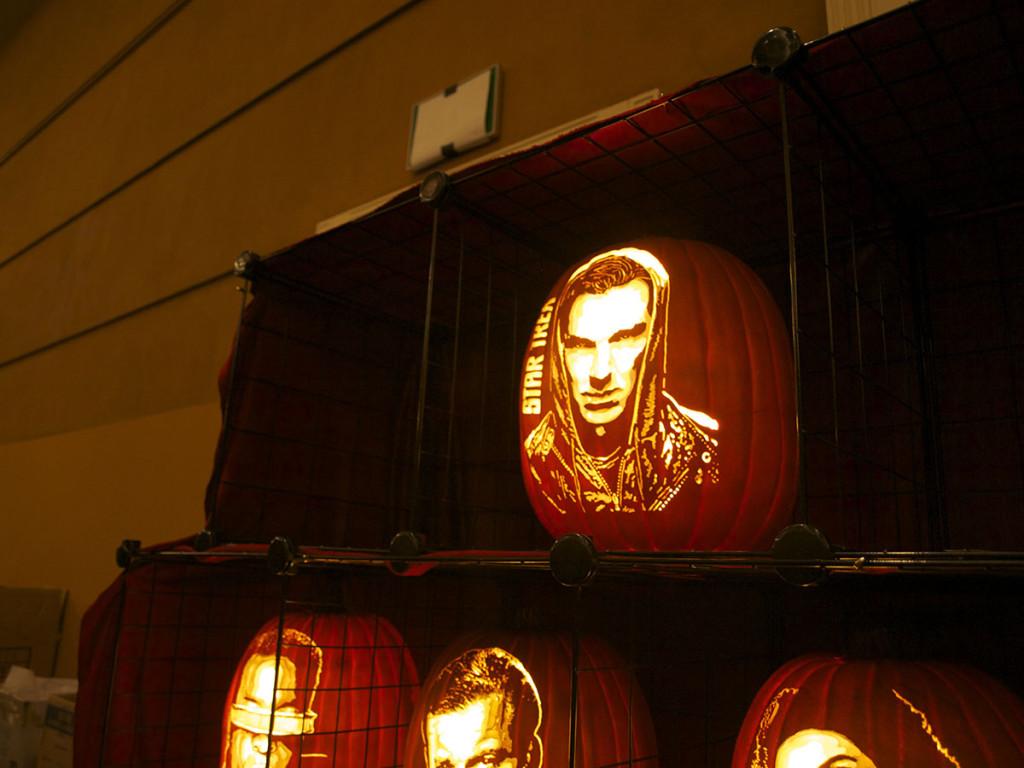My five-hour mission – to boldly go where no Urban School student has gone before
Middle-aged men in pointy ears. Thirty-something women with robotic-looking decorations circling their eyes. A pumpkin, on which actor Benedict Cumberbatch’s face was carved so intricately, I thought a three-dimensional printer must have been involved.
Where was I? On a different planet?
Well, almost. Fellow journalism student Griffin Bianchi (’16) and I were covering the Official Star Trek Convention, an event held at the Hyatt Regency in Burlingame, on Sunday, Nov. 10, its third and final day. The lobby and ballrooms were swarming with an estimated 300 Trekkies, most of who were dressed in costumes, the kind that come from places where no man (or woman) has gone before.
What’s behind this dedicated fandom? The original “Star Trek” television series first aired in 1966, and 47 years later, the official convention still sold out on all three days. The Sixties TV series has given birth to five spinoff shows, 12 motion pictures, more novels than a person could possibly read even in a Vulcan lifetime (200+ years), and nearly 3,000 listed fanfictions on fanfiction.net alone. While a representative from Creation Entertainment refused to give me exact numbers on convention attendance, she hinted it was several thousand.
Numbers aside, even among non-Trekkies there is a widespread belief that “Star Trek” was a revolutionary example of diversity, with a multicultural cast that included one of the first African American women to star in a television series (Lieutenant Uhuru, played by Michelle Nichols).
The newest generation of “Star Trek” movies promises to create a whole new crop of fans. The recent films, directed by J.J. Abrams, and starring hunk of man-love Chris Pine (as Captain Kirk) and the highly adored Cumberbatch (as the evil Khan) have drawn a younger, fresher audience to the film franchise. And yet Griffin and I were hard-pressed to find anyone at the convention under 30 years of age. We encountered one teenage girl, but she was alone, and dressed as The Doctor, from the popular British sci-fi television series, “Doctor Who.” Interesting as she was, you couldn’t call her a Trekkie. Or could you?
The only celebrities appearing at the convention were those of the Sixties series and films. But if the stars of Abrams’ films had been in attendance, we would have seen an audience made up of late middle- and early high-schoolers, mostly girls. They wouldn’t have been as good at Trek trivia, they wouldn’t have had the money for Trek memorabilia, and they might not have recognized William Shatner and Jeri Ryan. But they would have screamed louder. They would have tweeted. And that might have boosted attendance. While the “Star Trek” television show Facebook page has more than 2.5 million likes, the fan page specifically for Abrams’ movies has more than 3 million. Young Trekkies seem to outnumber older ones.
I experienced that firsthand when I went to see “Star Trek: Into Darkness” with a Cumberbatch-crazy friend. She kept hitting my arm and whispering “there he is!” whenever the actor appeared. I couldn’t pay attention to the movie, and she seemed not to really mind she was missing out on key plot points. In some ways, by bringing celebrities into the movies, “Star Trek” has created a strange new type of fandom, one akin to a boy band whose members you adore, but whose music you don’t really care about.
That could make for a divide between Trekkies old and new, but at the convention, we didn’t see it. After all, “Star Trek” is about acceptance. Griffin and I met all sorts of people at the convention: Black, white, big, small, dressed-up and plain. No one looked down on Griffin and me for being out of costume. No one refused to answer our questions or pose for pictures. The Trekkies we encountered modeled the behavior of the heroes on the show: Bold, kind, and clever. And I realized that just because my friends are drawn to “Star Trek” by an actor’s cheekbones and not by intricate plot lines involving Vulcan mind melds, it does not mean that they don’t deserve to be a part of this incredible community.
Even I, having only seen the parts of “Into Darkness” that I could catch while watching my friend “ooooh” and “ahhhhh” over Cumberbatch, felt welcomed with open arms. When I interviewed Michael Aron, an actor who played Jack London in two episodes of “Star Trek: The Next Generation,” he asked me what newspaper I was working for.
“The Urban Legend.”
“Oh.” He smiled. “I’ve heard of it.”
I seriously doubted this was true. However, I appreciated Aron’s attempt to make me feel proud of my high school paper.
“Here,” he said, leaning over to sign a headshot. “Take this.”
It was a photo that I could probably sell on Ebay, but Aron gave it to me for free. And in that moment, despite having never watched a single episode of “Star Trek,” I felt like family.
I felt bold.
I felt like a Trekkie.












